A scoop of California brown pelicans skims over the waves of Redondo Beach before splashing down into the Pacific Ocean’s cobalt waters.
Nearby, six surfers straddle boards and observe the waves crashing in a sucker-punching shore pound. I watch the bright sun shimmer off their orca-black wetsuits as they bob, paddle and catch waves. Behind them, the 444m-high mass of the Palos Verdes Peninsula towers over the ocean and blocks the views of Santa Catalina Island, situated some 35km offshore.
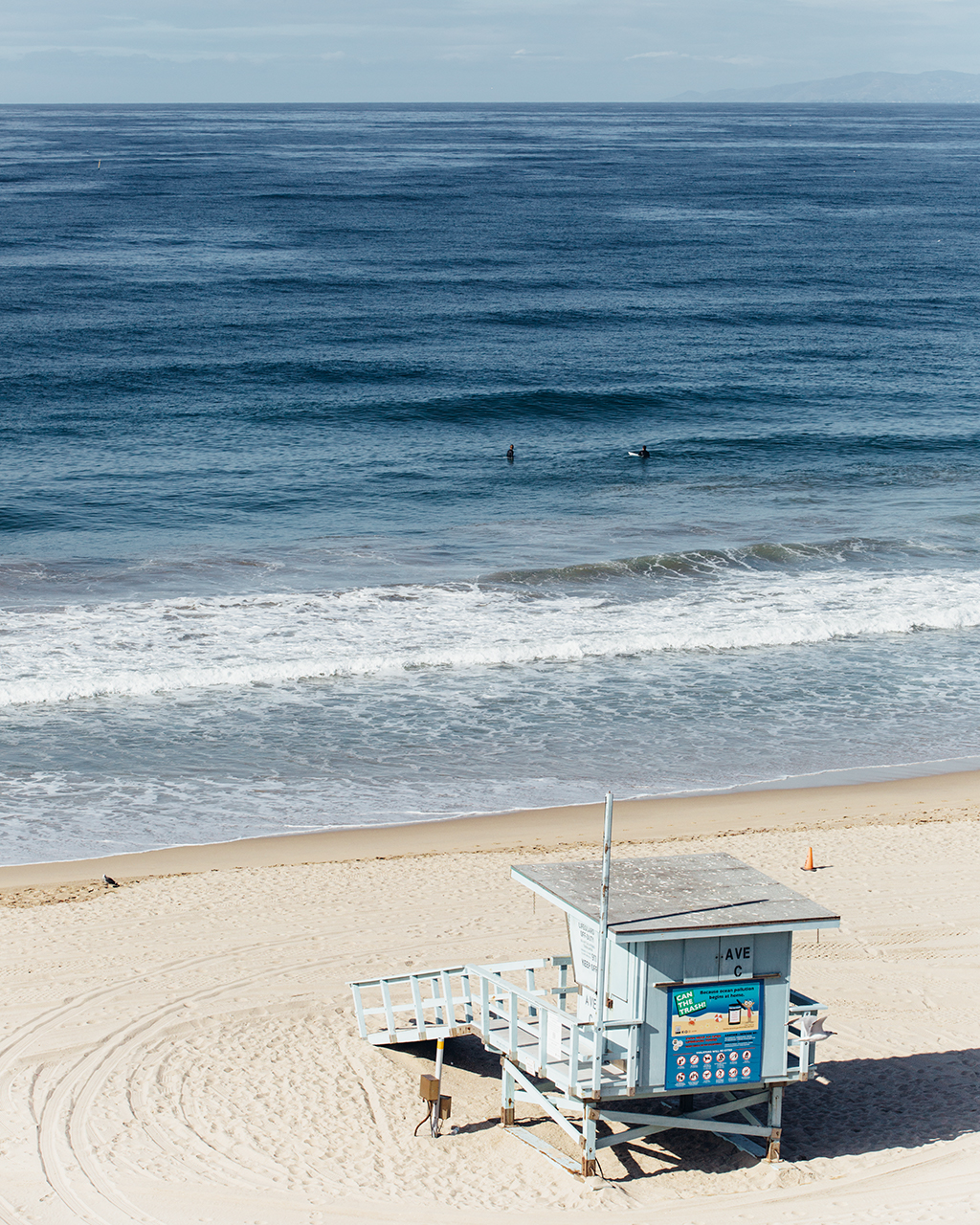
A man in an arm sling walking his young chocolate Labrador on the beach walk approaches me with a “shaka” – his thumb and pinky outstretched, middle fingers scrunched to his palm. He shakes his hand side to side. “Is that your van, man?” He asks as he eyes my rig, a 1979 Volkswagen Westfalia parallel-parked beside the esplanade. “For the next two days,” I say smiling, explaining that I’ve just rented it for a road trip that will cover the 233km to Joshua Tree National Park, passing through the sprawl of Los Angeles and Riverside counties, as well as the arid Colorado and Mojave deserts.
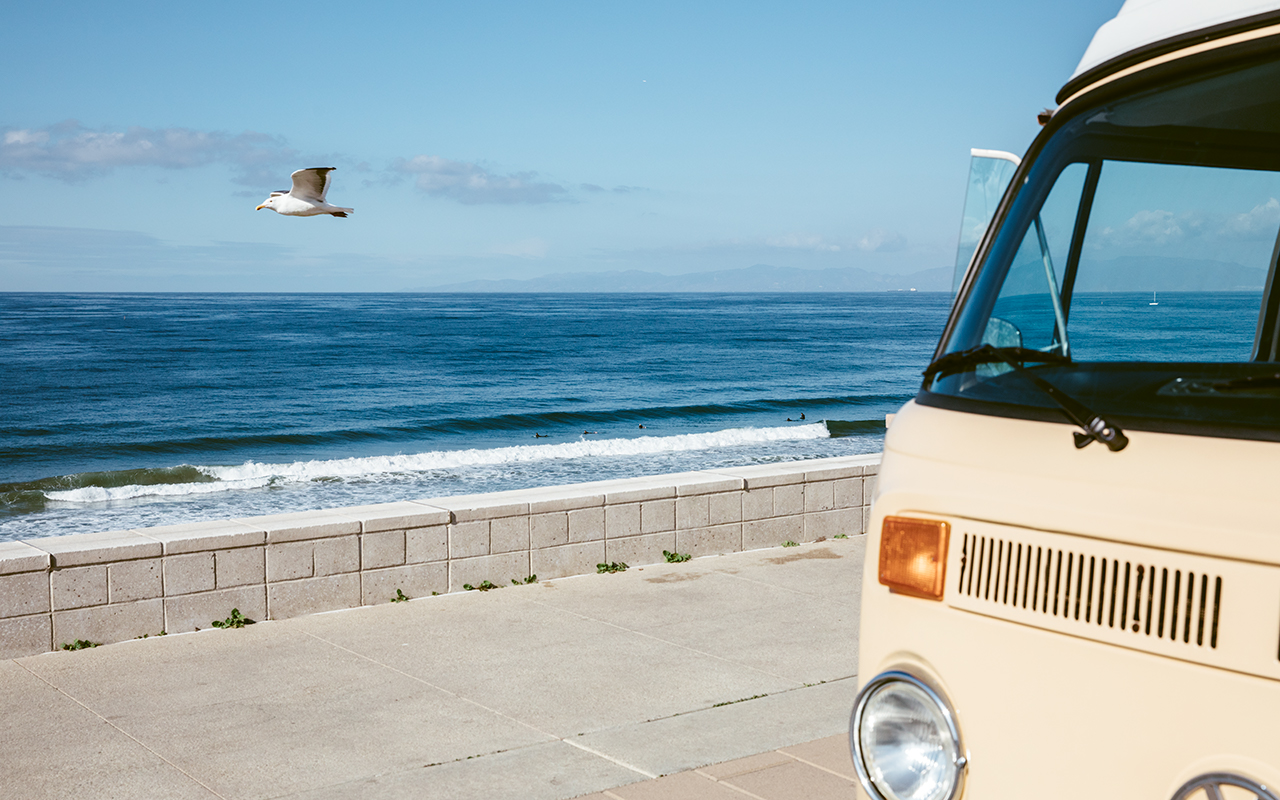
Earlier that day, I had travelled to pick up the van from owners Rob and Brooke Lykins, who purchased the vehicle two years ago after falling in love with the open road following a month-long RV trip with their two kids. Over coffee at their home, we discussed the cultural impact of the VW bus in observance of the 70th anniversary of the month the iconic VW Type 2 Bus first rolled off the production line back in March 1950. “I grew up in Southern California.” Brooke said. “The Type 2 was over 30 years old when I was in high school and I remember it being [many teenagers’] first car. It was the vehicle so many hardcore surfers and skateboarders used to get around in.”
Lying on the Lykinses’ coffee table was the book Vanlife Diaries: Finding Freedom on the Open Road. I flipped through its pages before heading outside to inspect the Westfalia. Inside were enchanting photographs of the nomadic lifestyles of vanlifers, many of them living out the dream in vintage VWs. One quote read, “It’s almost impossible not to smile when you see a colourful VW bus cruising down the highway. It embodies the spirit of festival season and summer surf trips. It’s an icon of the counterculture movement, carrying those who seek a cross-country adventure. Its often distinctive colours… stand out in a sea of everyday hues.”

The Lykinses’ beige Westfalia certainly brought a grin to my face when we checked it out outside their home. Whether it’s a Type 2 Microbus or one of the many generations that followed, the bread-loaf-shaped vehicles have become collector’s items as well as props for millennial travellers looking to live out their #vanlife fantasies. “I’d say about 80% of our renters for the VW are in their twenties,” Brooke said, when we discussed the bus’ Instagram-friendly aesthetic. “We get a lot of renters who are in it for the photos and I have to remind them of the vintage van’s realities,” Rob added. “The purpose of the trip is to take the slow roads, and that by driving the rig through locations like Highway 1, they become a part of the VW’s history and culture – they’re living the commercial.”
Underway, I cruise east in the slow lane at a leisurely 88km/h as six lanes of traffic dart by me. Going 16 under the speed limit, I take in views of the snow-capped San Gabriel Mountains more easily and appreciate their rocketing ridgeline that climaxes with the 3,068m Mount San Antonio. The peak is one of the three tallest mountains in Southern California I’ll pass on the road trip, collectively known as the Three Saints. The other two include the strikingly prominent San Jacinto Peak and the region’s tallest, the 3,506m San Gorgonio Mountain.
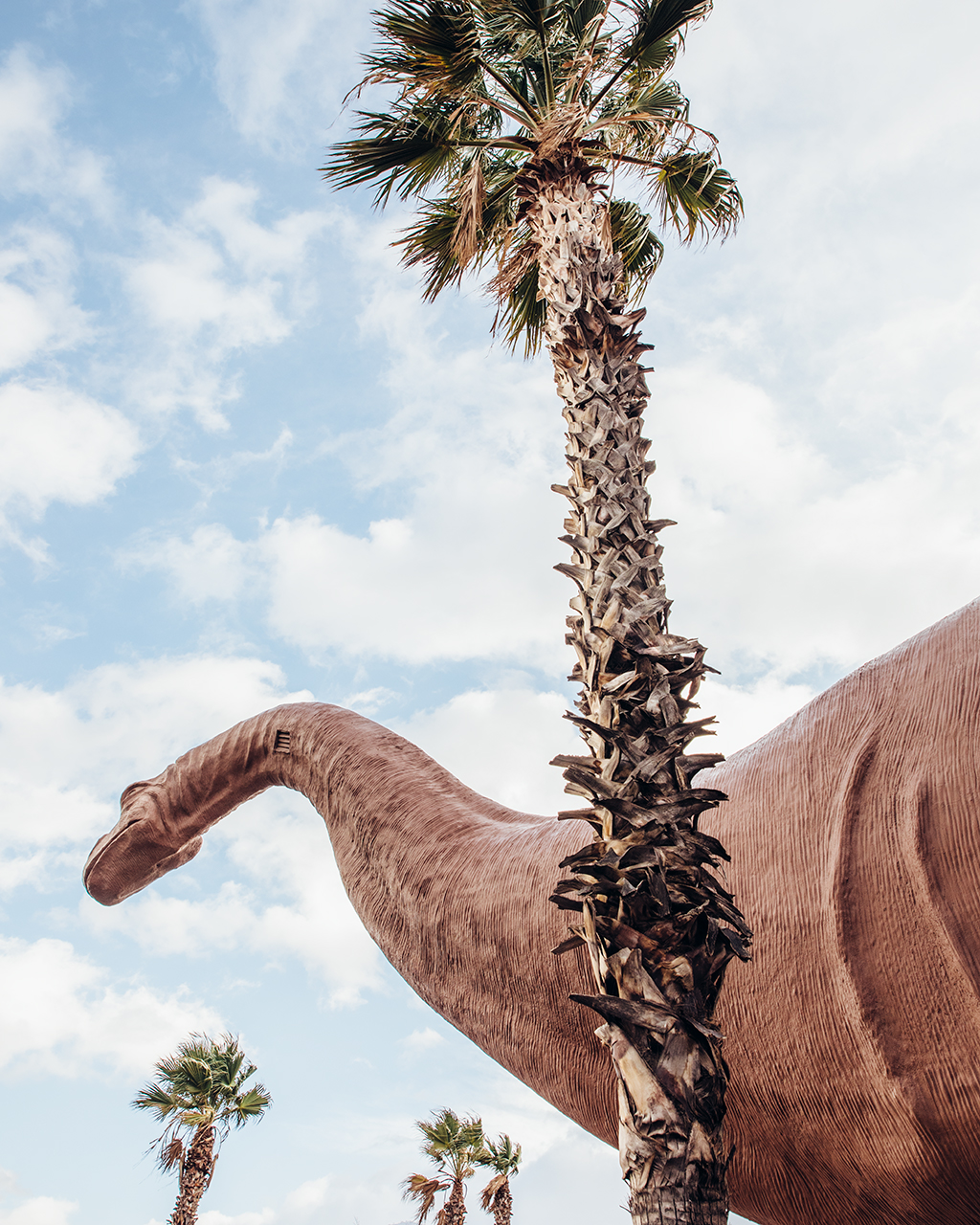
It isn’t long before I find myself entering the Colorado Desert in Cabazon, staring up at the small town’s famous roadside attraction: a 20m-tall Tyrannosaurus rex and a 45m-long Brontosaurus famous for their appearance in the 1985 road trip movie classic Pee-wee’s Big Adventure.
After inspecting the dinos, I hop back into the bus and take the exit for the Twentynine Palms Highway that ascends thousands of feet into the Mojave Desert. The immense San Jacinto Peak appears in my rear-view mirror as I drive. I think of the view from its icy summit when I climbed its challenging Cactus to Clouds Trail years ago – a view naturalist John Muir is said to have claimed was “the most sublime spectacle to be found anywhere on this earth!” From the top, you can spot Joshua Tree hanging like a massive veranda 1,220m above the Coachella Valley. To the northwest, Sand to Snow National Monument erupts from the soft edges of the valley.
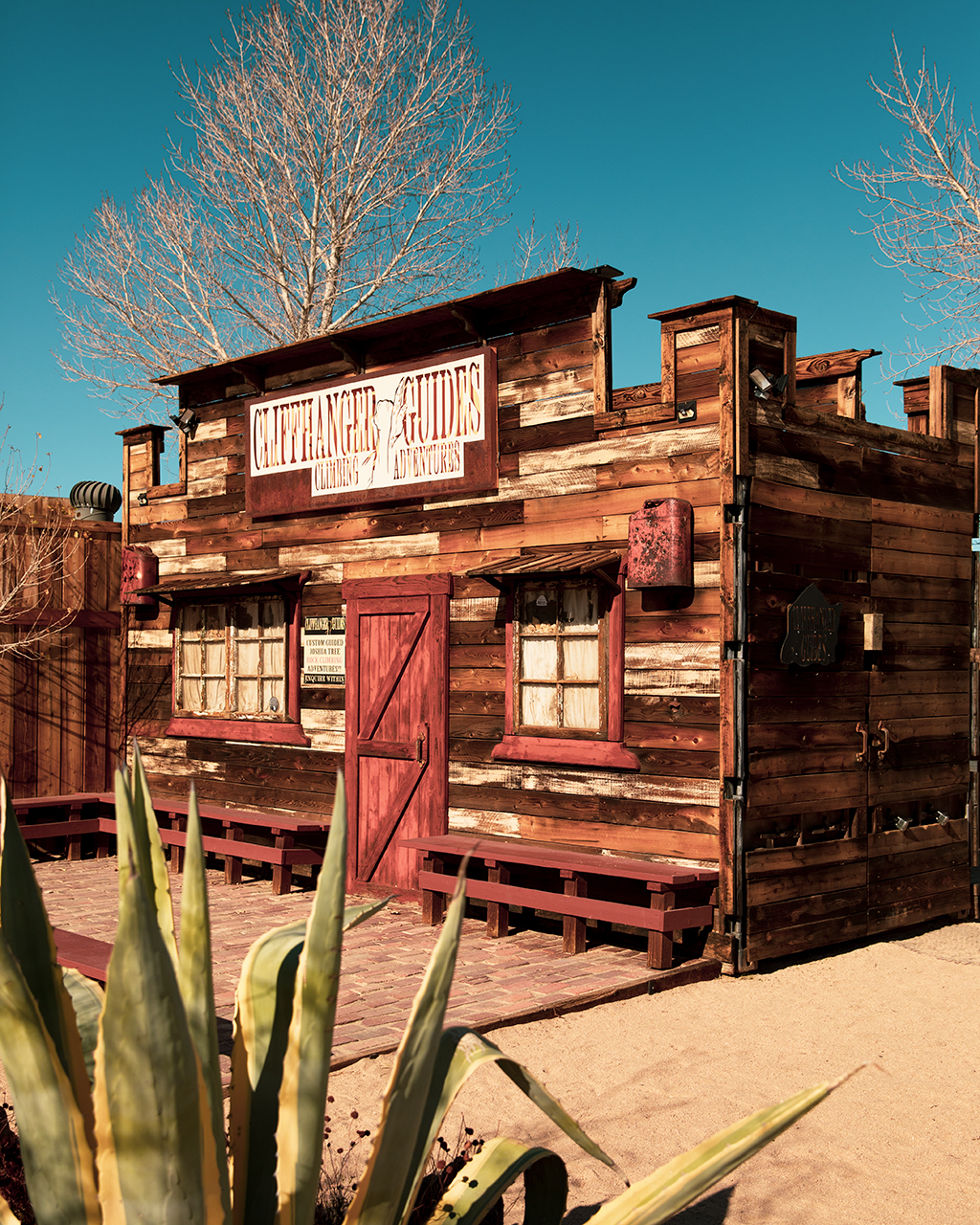
The Westfalia clambers the steep grades and slows to a worrisome 32km/h. Buses heavy with schoolchildren pass me. A Tesla Model S zips by so fast it almost catches flight on the mountain pass. Despite it all, the 41-year-old van crests the pass. I pat its hood and thank my lucky stars. I drift by Cactus Mart, a ’50s-themed diner and a handful of vintage clothing stores banking on the appeal of the desert-chic aesthetic.

After turning onto Park Boulevard in the community of Joshua Tree, the World Famous Crochet Museum catches my eye. The one-room museum hosts hundreds of crocheted figures: colourful depictions of ocotillo plants, poodles, a full nativity scene and an assortment of bright blue Smurfs. “The museum began when a friend brought me a couple of glass bottles covered in crocheted poodles,” Shari Elf, the museum’s owner, says, explaining that in 2006 she took her collection of crochet friends out of storage and started the museum that sits next to her store, Art Queen. Inside, she sells handmade creations constructed from desert trash she’s collected as well as screen-printed T-shirts and other knick-knacks. One item for sale is a painted rock that reads, “Hey! Why not smash your ‘smart’ phone with this rock?”
I pay the US$30 entry fee to a moustached ranger at Joshua Tree National Park’s West Entrance and arrive in the golden hours of the late afternoon. As I coast the curves of Park Boulevard, I approach the turn-off for the Barker Dam hiking loop, a trail that winds to an early-1900s cattleman’s dam and a petroglyph cave. I think of the indigenous cultures of the region, from the nearly 9,000-year-old Pinto Culture to the Chemehuevi, Cahuilla, Mojave, Western Shoshone and Serrano peoples.
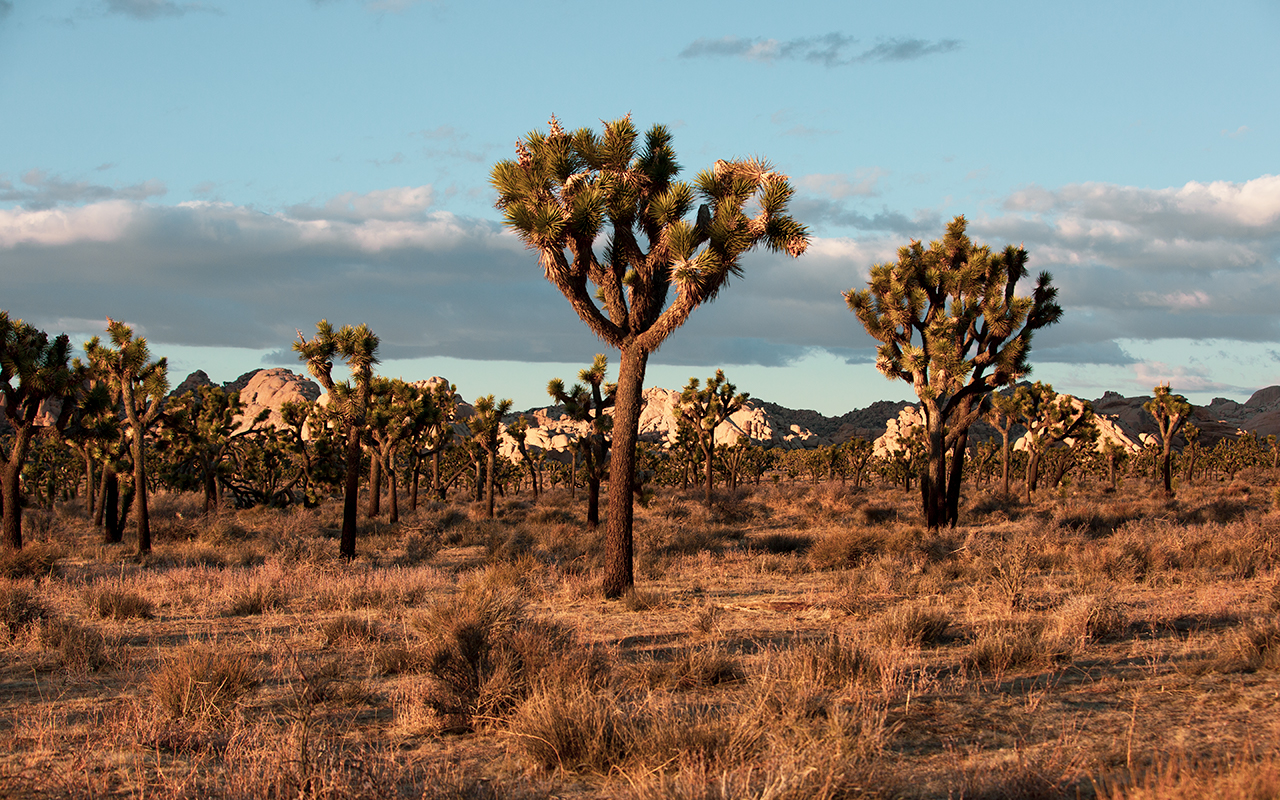
A ring of small, snowy mountain ranges encircles the flatlands punctuated by politely spaced Joshua trees. The whimsical, many-armed plants reach their spiky hands skyward. The afternoon sun bursts through the scattered clouds and ignites the dribble-drop castles of quartz monzonite boulders in a glorious clementine hue. When I look closely at Intersection Rock – one of the most popular climbing locations in the park – I spot rock climbers rappelling down after completing gruelling ascents.
In the distance, I notice the gentle slope of Mount Minerva Hoyt, a 1,647m peak named for the conservationist who advocated for the area’s protection to President Roosevelt in 1936. That resulted in the area’s designation as a monument, before it officially became Joshua Tree National Park in 1994. Due in part to Hoyt’s efforts and recommendations, Death Valley National Monument and Anza-Borrego Desert State Park were established in 1933, helping protect the spine of the state’s desert landscape.
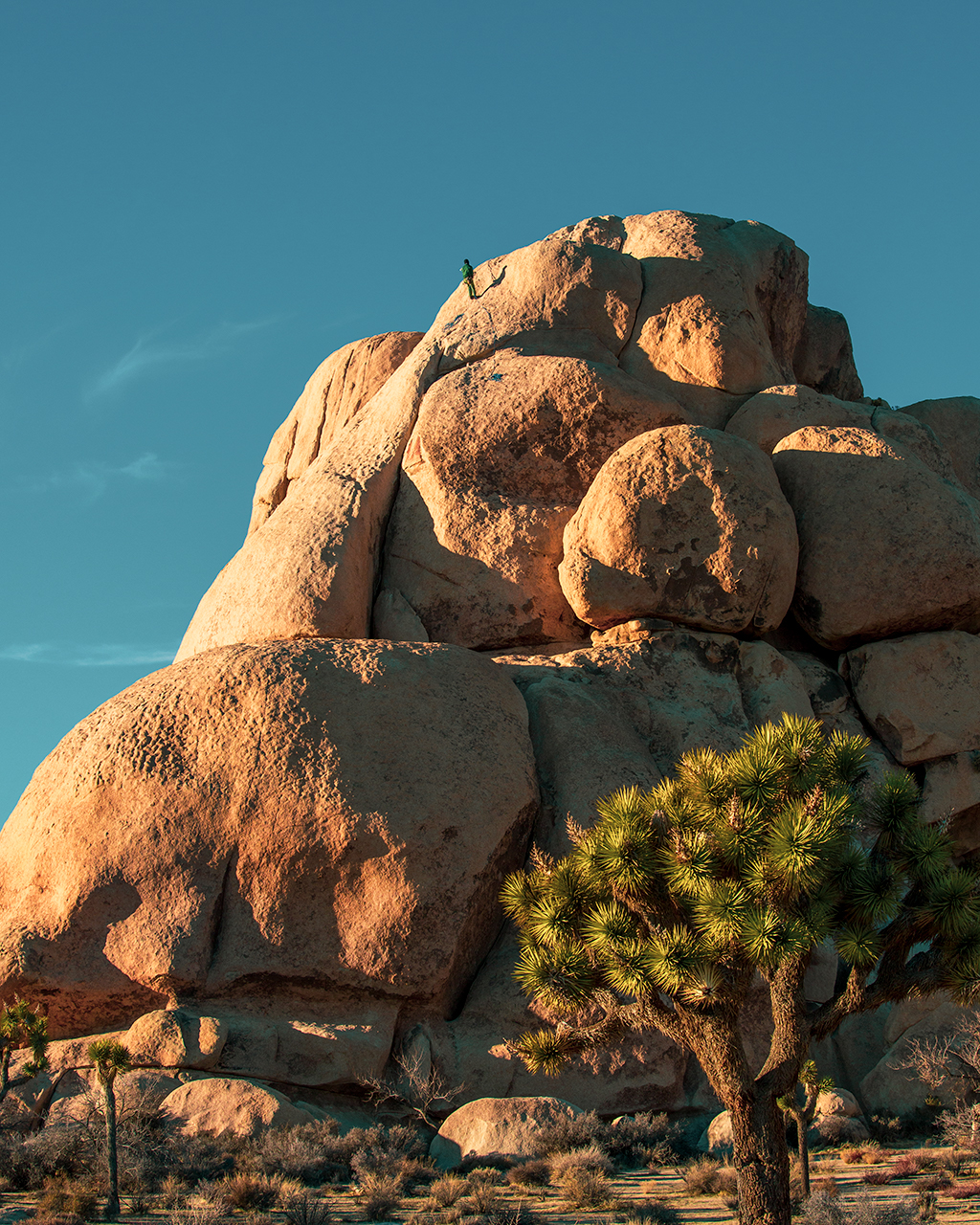
Every year, the Minerva Hoyt Desert Conservation Award is bestowed upon a prominent conservationist following in Hoyt’s footsteps. I speak with the 2018 recipient, Robin Kobaly, about Joshua Tree’s tourism explosion, which saw the number of visitors here leap from 1.2 million in 2000 to nearly three million in 2018.
“Many are unaware of how fragile a desert is,” Kobaly says, “Everything is on its own drawn-out time scale. If you disturb an area, it can take hundreds of years to recover.” Kobaly points to cryptobiotic crusts as an example – living algae, fungi, cyanobacteria and other organisms that stabilise the soil and help with nitrogen and carbon fixation. She also notes threatened species such as the desert tortoise and the desert bighorn sheep and mentions that some plants in the region have an average age between 600 and 1,000 years. “Everything visitors of the park see is ancient and critical,” she says. “It’s important to stay on the trail.”
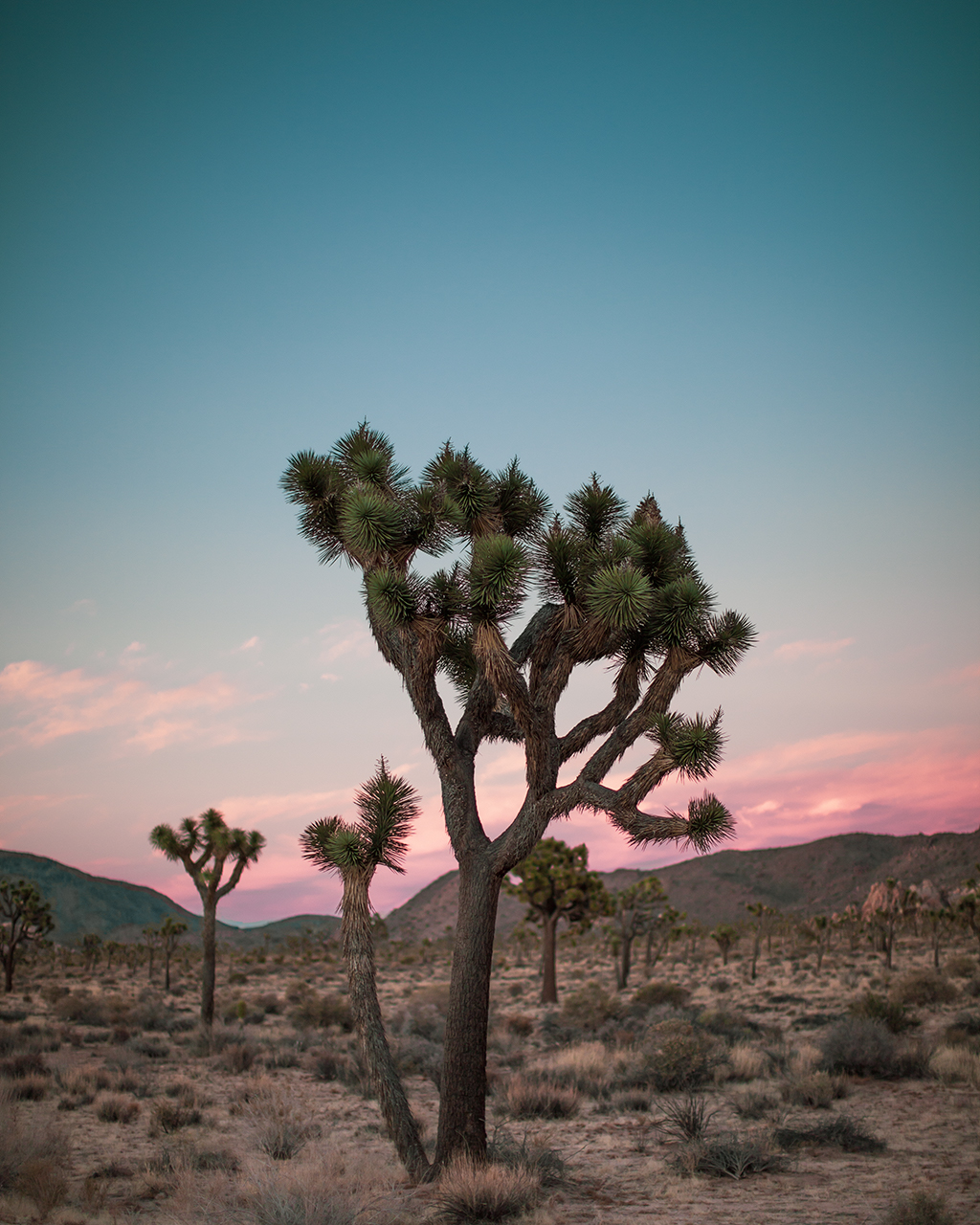
My eyes wander as I drive across the landscape of Joshua trees tossing their frenzied arms in the air as if they were juggling an invisible collection of razor-sharp throwing knives. While the park is named after the plants, they aren’t only found within its 321,000 hectares. In fact, they are a staple of the Mojave Desert with two separate species extending into Nevada, a small corner of southwest Utah and the western shoulder of Arizona. Looking at their twisted figures, it isn’t hard to imagine the Joshua trees tens of thousands of years ago – a time when Shasta ground sloths devoured their fruits and sabre-toothed cats may have rubbed against their shaggy trunks.
“Many are unaware of how fragile a desert is. Everything is on its own drawn-out time scale”
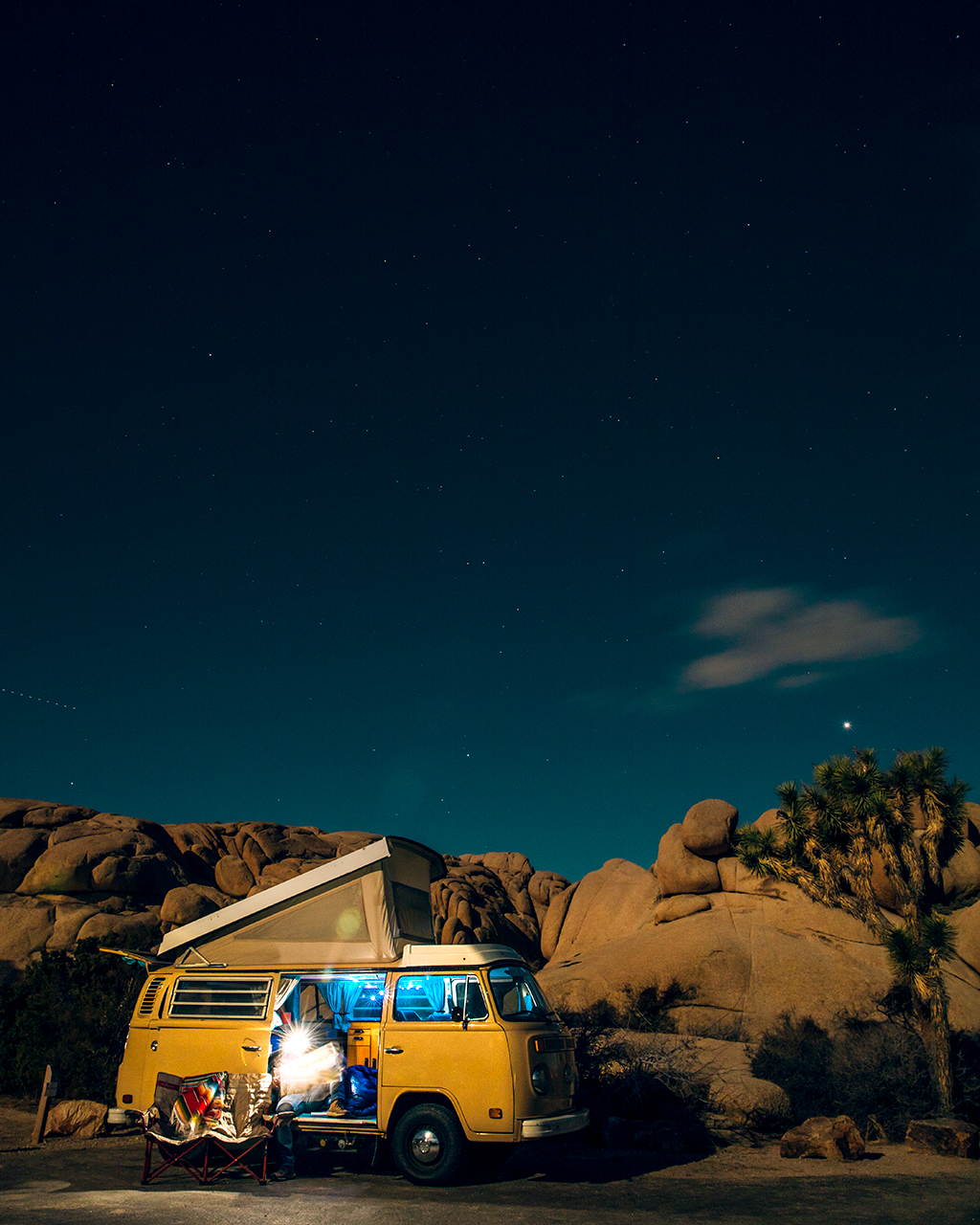
As the evening nears, I park the rig at the Jumbo Rocks Campground in a cosy nook between two boulders lit up by the sun’s last coral rays. Even on a frigid weeknight, Jumbo Rocks is bustling. Campers walk around in down jackets and set up their tents with cold fingers. I pop the Westfalia’s top and set up my bed on the roof’s cot. Before I start cooking, I honour my long-established camping tradition and go for a pre-supper stroll to get a better understanding of my surroundings.
The horizon settles into a calming periwinkle and the sun dips. An enormous full moon replaces it. I spot a coyote traipsing through a small patch of snow and hear a noisy California scrub jay in the crook of a Joshua tree. I scramble up a nearby boulder that takes me to a playground of rotund geology. From this height, the moon appears so close to earth that it doesn’t seem unreasonable to leap to its milky surface.
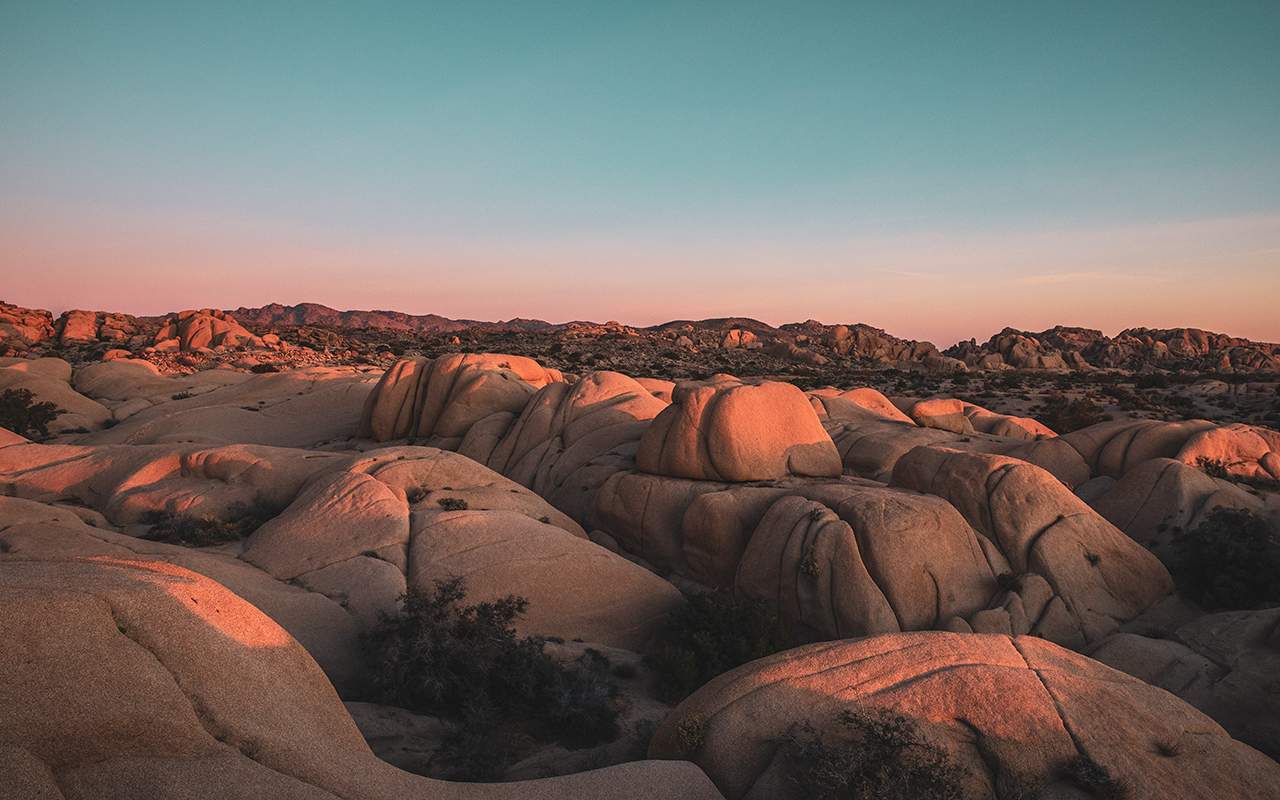
I determine uncertainties are ever-present on the long, winding days of #vanlife. The slow road can just as easily take you to the moon – and back. From my vantage point on these silvery rocks, I see the beige dot of the Westfalia on the boundless expanse of high desert. A quote I can’t help but agree with comes to me from Vanlife Diaries, the book I was flipping through in the Lykinses’ home before I began my trip. It goes something along the lines of: “The smaller the house, the bigger the backyard.”
Joshua trees in peril
Joshua Tree’s name comes from the giant yuccas, Yucca brevifolia, a monocotyledonous species that has been around for over two million years. However, a 2019 study predicted that the plants may be almost completely eliminated from the park by 2100. Lynn Sweet, an ecologist at the University of California at Riverside says, “If we persist at the same rate of greenhouse gas emissions, we could see very little, if not any habitable regions for Joshua trees to grow by the end of the century. The fate of the park’s trees all depends on human action.” With the stands in danger, Sweet believes the most important action for visitors is to leave as small a footprint as possible by staying on established trails, being responsible with campfires and reducing their carbon emissions by carpooling (as reducing air pollution in the region lessens the threat of wildfires).
Singapore Airlines flies to Los Angeles multiple times daily, including direct. To book a flight, visit singaporeair.com
SEE ALSO: Neighbourhood spotlight: Los Feliz, Los Angeles
This article was originally published in the March 2020 issue of SilverKris magazine
The post We take a road trip across California’s desert vistas in a retro campervan appeared first on SilverKris.
from SilverKris
No comments:
Post a Comment